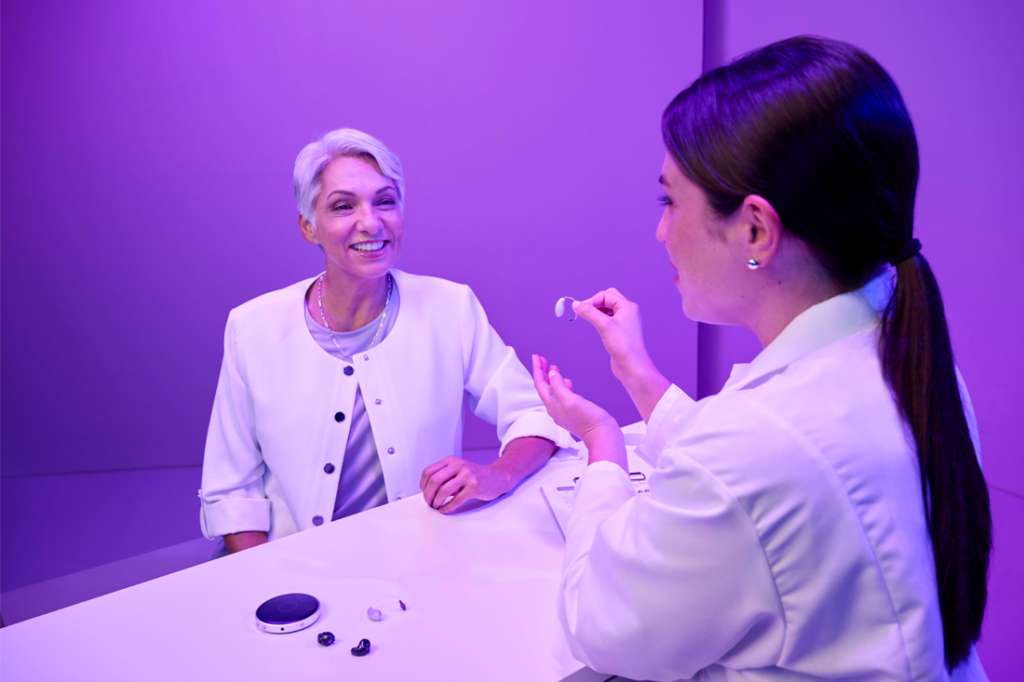My mom hated her hearing aids. Over the years, she tried several types and didn’t like any of them. Sometimes they hurt or were hard to put in, and other times they didn’t work well. As a result, she rarely wore them, even though she had significant hearing loss.
When we had family dinners, Mom would ask “What?” after every sentence or two that I, my husband or my daughter spoke. The same thing happened on telephone calls, which were even more difficult because she had the TV blasting at a loud volume in the background. When we were at a restaurant, she would nod as we were telling a story, but I could tell she couldn’t really hear what we were saying. It was frustrating for all of us.
Mom was embarrassed about her hearing loss, especially around her friends. She pretended to hear what they were saying in telephone conversations and in person, and it hurt her social connections. As a member of Generation X with hearing loss, I don’t want the same thing to happen to me.
So when I heard that Starkey had created an innovative hearing aid that was practically invisible, offered amazing sound quality, and was comfortable and easy to wear, I was—pun intended—all ears.
Hearing loss keeps accelerating
My hearing loss isn’t unusual. While it occurs most often in older adults—according to the World Health Organization, over 25% of people over 60 have some form of hearing loss—hearing challenges are increasing across all generations.
The World Health Organization also estimates that almost 2.5 billion people will have some form of hearing loss by 2050. Several factors that contribute to this trend include an aging population, exposure to loud noises like listening to devices at high volumes and health conditions such as diabetes and cardiovascular diseases.
There is currently no cure for age-related hearing loss and no medical or surgical treatment for noise-related hearing loss, but hearing aids may help.
Hearing loss threatens our social connections
Hearing is important for maintaining social connections.
Take social gatherings, for example. They are often held in meeting rooms or restaurants with a high level of background noise. This creates challenging situations for those with hearing loss, who often end up missing pieces of stories or entire conversations. And without those details, how can one contribute their own thoughts, stories or jokes during a get-together? Studies have shown that hearing loss can lead to social isolation and reduced relationships with family and friends, as well as anxiety, depression and loneliness.
Struggling through one-on-one conversations in person or over the phone with hearing loss can also lead to decreased social interactions, which can even affect the length of your life.
But hearing aids offer a potential lifeline.
“The No. 1 reason people don’t want a hearing aid is because of the stigma that they have seen,” says Brandon Sawalich, president and CEO of Starkey. “[They think] a hearing aid… [will] squeal with a high-frequency tone [or that] it’s a big piece of plastic in your ear.” But the clunky beige ones you may see in ads and on TV shows are a world away from today’s hearing aids.
Starkey’s history provides a glimpse into the progress of both the hearing aid industry and the company itself.
Becoming a leader in hearing aid technology
Starkey began with the entrepreneurial character of its founder, Bill Austin. At the young age of 19, Austin began to sell and repair hearing aids on the side to raise money for college. He was making repairs to patients’ hearing aids himself when he saw that better service was needed in this area. This led to his purchase of a small repair lab called Starkey Laboratories in 1967.
Austin’s vision of great customer service and patient care brought with it many firsts, including a 90-day money-back guarantee on hearing aids. This was a revolutionary concept in the early 1970s that has become an industry standard today.
In 1983, the company’s reputation skyrocketed when President Ronald Reagan was fitted with a Starkey hearing aid. By the following morning, orders for the products had more than quadrupled, nearly overwhelming the company’s operational capacity. This challenge inspired the company to further innovate, especially in manufacturing processes.
Today, Starkey is headquartered on a sprawling campus in Minnesota, where 1,400 employees continue the tradition of pioneering new technologies and improving patient care. The company has more than 5,000 employees globally and does business in more than 100 markets worldwide.
Each day, 20 to 30 people from around the world visit Starkey’s Center for Excellence at the Minnesota headquarters. Here, highly trained and licensed audiologists and professionals evaluate patients and fit them for hearing aids. These fittings also provide important data for the company’s research and development efforts. Some people who have received evaluations and fittings at the Center for Excellence include celebrities such as Elton John, Huey Lewis and Daymond John, along with a few former presidents.
Starkey is the only major American-owned hearing company, and one of the largest privately-held hearing aid companies, which allows the company to focus completely on its patients. “I have the luxury of not worrying about shareholder price or stock analysts,” Sawalich says. “[Instead] we are focused on what’s best for the patient, now and in the future.”
The company considers its employees to be family and provides each of them and their immediate families with free hearing aids. Sawalich and many other executives wear them too.
Starkey continues to lead the industry with technological innovations that improve quality of life. “I hired Achin Bhowmik, our chief technology officer, [in 2017],” Sawalich says. “I hired him from Intel…. [He] was an expert in the human perceptual design and bringing new thinking and thinking big into our industry.” The result was the Genesis AI hearing aid.
Hearing aid technology built for quality of life
Genesis uses a variety of technologies to improve hearing and social connections. Through Bluetooth, Genesis AI connects with smartphones and other devices, allowing users to stream audio—including calls, music and media—directly to their hearing aids. Genesis AI links to both Android and iOS platforms.
Genesis AI also includes health monitoring tools such as sensors that track physical activity and detect falls, which is particularly beneficial for older adults. This feature sends alerts to emergency contacts if sensors detect a fall.
As the name implies, artificial intelligence plays a major role in this hearing aid’s performance. Sawalich explains that AI in these devices does more than just amplify sound; it intelligently processes auditory data to distinguish between speech and noise.
Here are some of the ways Genesis AI does this:
- AI imitates the cerebral cortex to process sounds, and bridges the gap created by years of hearing loss by automatically making more than 80 million adjustments per hour.
- The hearing aid also conducts an analysis of the current listening environment and instantly adjusts to manage noise and directionality through a feature called Edge Mode+ on the MyStarkey app.
In addition to Edge Mode+, the MyStarkey app offers users a way to make easy adjustments to hearing aid settings and provides voice-to-text functionality that allows you to transcribe conversations in real-time, which can be especially useful in loud environments or when accurate recall is necessary. The app can also translate more than 70 languages.
When you speak into your smartphone, the app translates your speech and displays it on the screen in the other person’s language. When someone speaks another language into your phone, the app translates that speech, displays it in your language and sends the translated text directly to your hearing aids.
The impact of human touch on design
“[Our technicians and modelers] build and engineer and design a product that people wear for 14 hours a day, and they have to forget they’re wearing them,” Sawalich says. Starkey uses a combination of different types of technology, including silicon impressions, 3D scans and real-life fittings at its headquarters to continually improve the product.
Comfort is critical, as is invisibility. Genesis AI is small and rests behind the ears or subtly within the ears, making it barely visible to others. And since everyone’s ears are different, each Genesis AI hearing aid is customized based on a 3D scan of the ear, which is then sent to Starkey’s team of modelers to be manufactured.
Looking ahead, Starkey is investigating ways to use technology to integrate more holistic health features into its hearing aids. But according to Sawalich, the company’s purpose of “build[ing] caring products that connect people to people” will always remain the same.
This article originally appeared in the July issue of SUCCESS+ digital magazine. Photo courtesy Starkey





